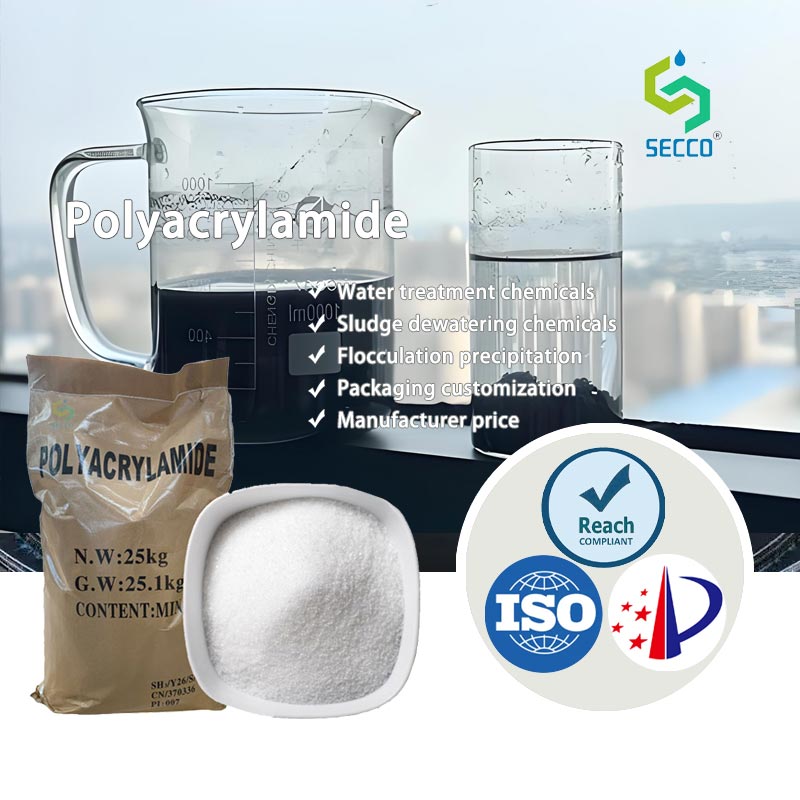Secco Polyacrylamide (PAM) is a highly effective polymeric flocculant widely used in coal washing wastewater treatment. It primarily removes suspended solids (SS) and colloidal particles through flocculation and sedimentation.

Below is a comprehensive technical analysis:
1. Technical Principles
Flocculation Mechanism:
PAM’s active groups (—CONH₂) adsorb onto coal slurry particles, neutralizing surface charges and forming “bridges” to aggregate fine particles into larger flocs for rapid settling.
Anionic PAM (APAM): Suitable for alkaline wastewater (typical in coal washing) with negatively charged particles.
Non-ionic PAM (NPAM): Used for neutral or weakly acidic wastewater.
Cationic PAM (CPAM): Rarely used unless treating organic-rich or positively charged colloids.
Synergistic Effects:
Often combined with inorganic coagulants (e.g., PAC) for charge neutralization followed by PAM-enhanced flocculation.
2. Key Technical Parameters
Dosage:
Typically 0.1–10 mg/L, determined via jar tests. Excess PAM may cause re-stabilization or fragile flocs.
Dissolution & Preparation:
PAM must be dissolved to 0.1%–0.5% solution with ≥40 min stirring to avoid clumping.
Mixing Conditions:
Rapid mixing (200–300 rpm) for dispersion, followed by slow mixing (20–50 rpm) for floc growth.
3. Advantages
High Efficiency: Reduces settling time by >50%, achieving 90%–95% SS removal.
Sludge Dewatering: Forms dense flocs, improving filter press efficiency.
Cost-Effectiveness: Low chemical cost (~$0.05–0.12 per ton of water).
Environmental Safety: PAM is non-toxic, but residual acrylamide must be <0.05%.
4. Common Challenges & Solutions
Incorrect PAM Selection:
Conduct jar tests to optimize type (APAM/NPAM) and molecular weight (typically 8–12 million).
pH Sensitivity:
APAM works best at pH 7–10; acidic wastewater requires pH adjustment or NPAM.
Incomplete Dissolution:
Use dedicated dissolving equipment to prevent “fish eyes.”
Floc Breakage:
Over-mixing or overdosing may destabilize flocs; optimize operational parameters.
5. Case Study
Coal Mine Wastewater Plant:
Influent: SS 2000–5000 mg/L, pH 8–9.
Process: PAC (50 mg/L) + APAM (2 mg/L).
Results: Effluent SS <50 mg/L; sludge moisture reduced from 98% to 75% after filtration.
6. Future Improvements
Composite Formulations: Combine PAM with bio-agents for COD/heavy metal removal.
Smart Dosing Systems: Real-time turbidity monitoring for dynamic dosing.
Green PAM Modifications: Starch-grafted PAM for better biodegradability.
Conclusion
PAM is a mature and cost-effective solution for coal washing wastewater, but performance depends on proper selection and process optimization. Integrated with pretreatment (screening) and post-treatment (filter pressing), it forms a complete treatment system.
If you have any further questions or requirements regarding polyacrylamide, please feel free to contact Secco at any time!